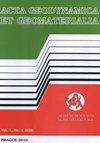基于遥感和地球物理数据分析的水资源勘探与管理:埃及西奈中东部Al-Naqab流域
IF 0.8
4区 地球科学
Q4 GEOCHEMISTRY & GEOPHYSICS
引用次数: 0
摘要
本研究整合了遥感和地球物理数据,以确定Naqab水库流域的水文条件。本研究的主要目的是识别和解释地下结构及其对地下水流的影响、结构与地下水之间的关系以及该子流域流域管理的最佳方式。地球物理数据,包括地面磁测和一维电阻率测深,有助于识别岩性和划定地下水赋存区域。磁性数据描绘了基岩,有助于表征控制地表特征和约束地下水流动系统的地下结构的几何形状。解释的地下结构元素包括六组走向为NE-SW、NW-SE、NWW-SEE、NEE-WW、N-S和E-W的断层。南部的基底深度估计为零,北部的基底深度约为5187m。表征了两个含水层系统,Wata组(上白垩纪)的浅层含水层和Malha组(下白垩纪)的深层含水层。地下水出现的概率随着研究区中心向北增加,沉积盆地的厚度在研究区中心达到最大值。根据沿两个断面的地电剖面,对断层的不同走向进行了解释。断层分为三种类型:阶状断层、地堑式断层和地垒式断层。这些断层可以通过地层厚度的显著差异在地电剖面上显示出来。磁性数据证实了电阻率剖面所描绘的断层位置。概述的断层主要呈NE-SW、NW-SE、NWW-SEE、NEE-SWW和E-W方向。利用遥感(RS)数据和地理信息系统(GIS)技术对水系结构划分和水系格局分析进行了评价和解释。SRTM-DEM(航天飞机雷达地形任务数字高程模型)也被用于自动识别和提取排水网络。对推断的线理结构的解释和分析表明,存在许多主要的线理种群,这些种群的趋势是:NE-SW、NW-SE、NNW-SSE、NWW-SEE、E-W和N-S。同时,对水系网络的解释和分析表明,存在三种主要的线性构造,其走向为:NW-SE、NE-SW和NWW-SEE。测量结构和排水渠的方位分布分析显示出相似的趋势,只是主要趋势差异很小。在所研究的地区,人们认识到了线性构造、排水系统和地下构造趋势的相似性。总之,遥感和地球物理数据的结合表明,可以验证地表结构线理和地下结构趋势之间的密切匹配。可以确定地表径流和地下水流的首选管道,以及地下水开采的适当位置。本文章由计算机程序翻译,如有差异,请以英文原文为准。
Water resources exploration and management based on remote sensing and geophysical data analysis:
Al-Naqab Watershed, East Central Sinai, Egypt
This study integrates remote sensing and geophysical data to identify the hydrological conditions of the Naqab reservoir watershed. The main objectives of this study are identification and the interpretation of subsurface structures and their impact on groundwater flow, the relationships between structures and groundwater and the optimum way for watershed management in this sub-basin. Geophysical data including, ground magnetic survey and 1D electrical resistivity sounding helped in identifying the lithology and delineating zones of groundwater occurrence. The magnetic data delineated the basement rock, aided in characterizing the geometry of the subsurface structures that control the land surface features and constrain groundwater flow system. The interpreted subsurface structure elements include six sets of faults trending NE-SW, NW-SE, NWW-SEE, NEE-SWW, N-S and E-W. The basement depth was estimated at zero at the southern part and about 5187 m at the northern part. Two aquifer systems were characterized, the shallow aquifer of the Wata Formation (Upper Cretaceous) and the deep aquifer of the Malha Formation (Lower Cretaceous). The probability of groundwater occurrence increases towards the central part of the study area to north direction, where the thickness of the sedimentary basin reaches its maximum at the center of the study area. Different trends of faults were interpreted from the geo- electrical cross-sections along two transects. Three patterns of faults were characterized including step faults, graben faults and horst faults. These faults could be indicated on the geo-electrical section by a marked difference in the layers` thicknesses. The magnetic data confirmed the locations of the faults delineated by the electrical resistivity profiles. The outlined faults are trending mainly in NE-SW, NW-SE, NWW-SEE, NEE-SWW and E-W directions. Lineament structures delineation and drainage pattern analysis were evaluated and interpreted from the analysis of remote sensing (RS) data and geographic information system (GIS) technique. The SRTM-DEM (Shuttle Radar Topographic Mission-Digital Elevation Model) was also utilized to automatically identify and extract drainage network. Interpretation and analysis of the inferred lineament structures indicate the presence of a number of main lineament populations that trends: NE-SW, NW-SE, NNW-SSE, NWW-SEE, E-W and N-S. Meanwhile, the interpretation and analysis of drainage pattern network indicate the presence of three main lineament structures that trends: NW-SE, NE-SW and NWW-SEE. Azimuth distribution analysis of both the measured structures and drainage channels shows similar trends, except for very few differences in the prevailing trends. Similarity in orientation of lineament structures, drainage system, and subsurface structural trends were recognized in the area under study. In conclusion, the integration between remote sensing and geophysical data revealed a close matching between the surface structural lineaments and subsurface structural trends could be verified. The preferred conduits of surface run-off and groundwater flow, as well as, the proper locations for groundwater exploitation could be determined.
求助全文
通过发布文献求助,成功后即可免费获取论文全文。
去求助
来源期刊

Acta Geodynamica et Geomaterialia
地学-地球化学与地球物理
CiteScore
2.30
自引率
0.00%
发文量
12
期刊介绍:
Acta geodynamica et geomaterialia (AGG) has been published by the Institute of Rock Structures and Mechanics, Czech Academy of Sciences since 2004, formerly known as Acta Montana published from the beginning of sixties till 2003. Approximately 40 articles per year in four issues are published, covering observations related to central Europe and new theoretical developments and interpretations in these disciplines. It is possible to publish occasionally research articles from other regions of the world, only if they present substantial advance in methodological or theoretical development with worldwide impact. The Board of Editors is international in representation.
 求助内容:
求助内容: 应助结果提醒方式:
应助结果提醒方式:


